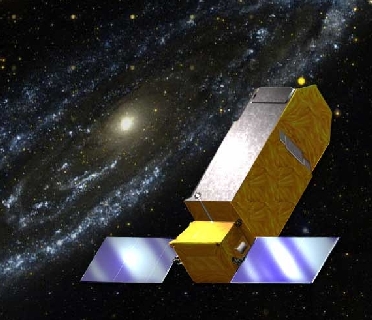

Mission Status Report #78 Star Date: November 12, 2004
All is Well!Caption: This spiffy new graphic shows an artist's concept of the FUSE satellite's on-orbit confirguration, superimposed on an ultraviolet light image of the Andromeda galaxy from the Galex satellite. (FUSE/JHU graphic courtesy of Lauren Fowler, JHU.)
Operations on the FUSE satellite continue to go well since my last report. Operations continue at this point using a single gyro in the control loop. With over a month and a half of one-gyro operations under our belts, all is operating smoothly and as expected. (One-gyro operations are currently being used due to a noisy gyro that developed during the June-Sept. 2004 period. See this previous report.) We have now had time to assess FUSE performance through the first half of Cycle 5 (Apr. 1 - Sept. 30, 2004) and compare against earlier performance. Overall performance has continued to be excellent, with a science efficiency of over 32%. This is lower than the 37% achieved during Cycle 4, but is essentially the mission average value. More importantly, the lower overall percentage is due to our more aggressive attempts to work specifically on reducing the backlog of targets from earlier cycles that are still awaiting observation. These are not always the most efficient observations, but we feel it is a good trade to give up some overall efficiency to give these specific accepted observations their day in the sun, so to speak. The strategy is working well, as the backlog has been whittled down significantly over the last six months. By the end of Cycle 5 in March 2005, we should have a much smaller carryover from earlier cycles than we have had previously. The FUSE Observers Advisory Committee (FOAC) met in Paris, France, during the first week of November. The Paris meeting was an acknowledgement by the project of the significant support we have received over the years from our French partners at the Institut d'Astrophysique Paris and the Centre National d-Etudes Spatiales (CNES) (the French space agency). The FOAC heard about project status, deliberated over options for use of our limited resources, and generally provided important feedback to project scientist George Sonneborn and the operations team about Cycle 6 plans and downstream operations. It was an excellent meeting, and we thank our local hosts for their hospitality. It is encouraging to see that FUSE results are popping up in the scientific literature ever more frequently with each passing year. As of the end of October 2004, there have been nearly as many refereed FUSE publications (63) as there were in ALL of calendar year 2003 (66). With many more publications still in preparation it is looking like a banner year for FUSE results! The deadline for Cycle 6 FUSE proposals was Sept. 17, 2004. NASA received a record number of new proposals for potential observation in Cycle 6, for a record amount of requested time. Competition will be stiff, but we take this as a good sign that the astronomical community still holds a keen interest in new FUSE observations! Proposal selections will be made later this fall with results announced near the end of the year. Good luck to those who proposed!
Reported by: Bill Blair, FUSE Chief of Observatory Operations
|
